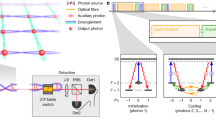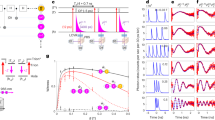Abstract
Quantum computers promise ultrafast performance for certain tasks1. Experimentally appealing, measurement-based quantum computation2 requires an entangled resource called a cluster state3, with long computations requiring large cluster states. Previously, the largest cluster state consisted of eight photonic qubits4 or light modes5, and the largest multipartite entangled state of any sort involved 14 trapped ions6. These implementations involve quantum entities separated in space and, in general, each experimental apparatus is used only once. Here, we circumvent this inherent inefficiency by multiplexing light modes in the time domain. We deterministically generate and fully characterize a continuous-variable cluster state7,8 containing more than 10,000 entangled modes. This is, by three orders of magnitude, the largest entangled state created to date. The entangled modes are individually addressable wave packets of light in two beams. Furthermore, we present an efficient scheme for measurement-based quantum computation on this cluster state based on sequential applications of quantum teleportation.
This is a preview of subscription content, access via your institution
Access options
Subscribe to this journal
Receive 12 print issues and online access
$209.00 per year
only $17.42 per issue
Buy this article
- Purchase on Springer Link
- Instant access to full article PDF
Prices may be subject to local taxes which are calculated during checkout




Similar content being viewed by others
References
Nielsen, M. A. & Chuang, I. L. Quantum Computation and Quantum Information (Cambridge Univ. Press, 2000).
Raussendorf, R. & Briegel, H. J. A one-way quantum computer. Phys. Rev. Lett. 86, 5188–5191 (2001).
Briegel, H. J. & Raussendorf, R. Persistent entanglement in arrays of interacting particles. Phys. Rev. Lett. 86, 910–913 (2001).
Yao, X.-C. et al. Observation of eight-photon entanglement. Nature Photon. 6, 225–228 (2012).
Su, X. et al. Experimental preparation of eight-partite cluster state for photonic qumodes. Opt. Lett. 37, 5178–5180 (2012).
Monz, T. et al. 14-Qubit entanglement: creation and coherence. Phys. Rev. Lett. 106, 130506 (2011).
Zhang, J. & Braunstein, S. L. Continuous-variable Gaussian analog of cluster states. Phys. Rev. A 73, 032318 (2006).
Menicucci, N. C. et al. Universal quantum computation with continuous-variable cluster states. Phys. Rev. Lett. 97, 110501 (2006).
Einstein, A., Podolsky, B. & Rosen, N. Can quantum-mechanical description of physical reality be considered complete? Phys. Rev. 47, 777–780 (1935).
Bell, J. S. On the Einstein–Podolsky–Rosen paradox. Physics 1, 195–200 (1964).
Furusawa, A. & van Loock, P. Quantum Teleportation and Entanglement (Wiley-VCH, 2011).
Bennett, C. H. et al. Teleporting an unknown quantum state via dual classical and Einstein–Podolsky–Rosen channels. Phys. Rev. Lett. 70, 1895–1899 (1993).
Furusawa, A. et al. Unconditional quantum teleportation. Science 282, 706–709 (1998).
Lee, N. et al. Teleportation of nonclassical wave packets of light. Science 332, 330–333 (2011).
Walther, P. et al. Experimental one-way quantum computing. Nature 434, 169–176 (2005).
Tokunaga, Y. et al. Generation of high-fidelity four-photon cluster state and quantum-domain demonstration of one-way quantum computing. Phys. Rev. Lett. 100, 210501 (2008).
Ukai, R. et al. Demonstration of unconditional one-way quantum computations for continuous variables. Phys. Rev. Lett. 106, 240504 (2011).
Ukai, R., Yokoyama, S., Yoshikawa, J., van Loock, P. & Furusawa, A. Demonstration of a controlled-phase gate for continuous-variable one-way quantum computation. Phys. Rev. Lett. 107, 250501 (2011).
Yukawa, M., Ukai, R., van Loock, P. & Furusawa, A. Experimental generation of four-mode continuous-variable cluster states. Phys. Rev. A 78, 012301 (2008).
Van Loock, P., Weedbrook, C. & Gu, M. Building Gaussian cluster states by linear optics. Phys. Rev. A 76, 032321 (2007).
Armstrong, S. et al. Programmable multimode quantum networks. Nature Commun. 3, 1026 (2012).
Pysher, M., Miwa, Y., Shahrokhshahi, R., Bloomer, R. & Pfister, O. Parallel generation of quadripartite cluster entanglement in the optical frequency comb. Phys. Rev. Lett. 107, 030505 (2011).
Roslund, J., de Araújo, R. M., Jiang, S., Fabre, C. & Treps, N. Wavelength-multiplexed quantum network with ultrafast frequency combs. Preprint at http://lanl.arXiv.org/abs/1307.1216 (2013).
Menicucci, N. C., Flammia, S. T. & Pfister, O. One-way quantum computing in the optical frequency comb. Phys. Rev. Lett. 101, 130501 (2008).
Menicucci, N. C. Temporal-mode continuous-variable cluster states using linear optics. Phys. Rev. A 83, 062314 (2011).
Usmani, I., Afzelius, M., de Riedmatten, H. & Gisin, N. Mapping multiple photonic qubits into and out of one solid-state atomic ensemble. Nature Commun. 1, 12 (2010).
Gu, M., Weedbrook, C., Menicucci, N. C., Ralph, T. C. & van Loock, P. Quantum computing with continuous-variable clusters. Phys. Rev. A 79, 062318 (2009).
Menicucci, N. C., Flammia, S. T. & van Loock, P. Graphical calculus for Gaussian pure states. Phys. Rev. A 83, 042335 (2011).
Van Loock, P. & Furusawa, A. Detecting genuine multipartite continuous-variable entanglement. Phys. Rev. A 67, 052315 (2003).
Acknowledgements
This work was partly supported by the Project for Developing Innovation Systems (PDIS), Grants-in-Aid for Scientific Research (GIA), the Global Center of Excellence (G-COE) and the Advanced Photon Science Alliance (APSA) commissioned by the Ministry of Education, Culture, Sports, Science and Technology (MEXT) of Japan, the Funding Program for World-Leading Innovative R&D on Science and Technology (FIRST) initiated by the Council for Science and Technology Policy (CSTP) of Japan, and the Australian Research Council (ARC) Centre of Excellence for Quantum Computation & Communication Technology (CQC2T; project number CE110001027). S.Y. acknowledges financial support from Advanced Leading Graduate Course for Photon Science (ALPS). R.U. acknowledges support from the Japan Society for the Promotion of Science (JSPS). S.A. acknowledges financial support from the Prime Minister's Australia Asia Award. N.C.M. was supported by the ARC (grant no. DE120102204).
Author information
Authors and Affiliations
Contributions
S.Y., R.U. and S.A. planned and designed the experiment under the supervision of J.Y., H.Y. and A.F., based on the proposal by N.C.M. The experimental set-up were designed by S.Y., and the optical set-up was constructed by C.S., T.K. and S.Y. The fibre alignment system was built by S.S. The theory was formulated by R.U., S.A., N.C.M. and J.Y. R.U. designed and constructed the data acquisition system. S.A. designed and constructed the digital control system. R.U., S.A., T.K. and S.Y. conducted the data analysis. H.Y. assisted in noise analysis. S.Y. and S.A. wrote the manuscript with assistance from the team.
Corresponding author
Ethics declarations
Competing interests
The authors declare no competing financial interests.
Supplementary information
Supplementary information
Supplementary information (PDF 1128 kb)
Rights and permissions
About this article
Cite this article
Yokoyama, S., Ukai, R., Armstrong, S. et al. Ultra-large-scale continuous-variable cluster states multiplexed in the time domain. Nature Photon 7, 982–986 (2013). https://doi.org/10.1038/nphoton.2013.287
Received:
Accepted:
Published:
Issue Date:
DOI: https://doi.org/10.1038/nphoton.2013.287
This article is cited by
-
Soliton pulse pairs at multiple colours in normal dispersion microresonators
Nature Photonics (2023)
-
Demonstration of fully-connected quantum communication network exploiting entangled sideband modes
Frontiers of Physics (2023)
-
Ultra-low-power second-order nonlinear optics on a chip
Nature Communications (2022)
-
Deterministic multi-mode gates on a scalable photonic quantum computing platform
Nature Physics (2021)
-
Thermodynamic resources in continuous-variable quantum systems
npj Quantum Information (2021)



